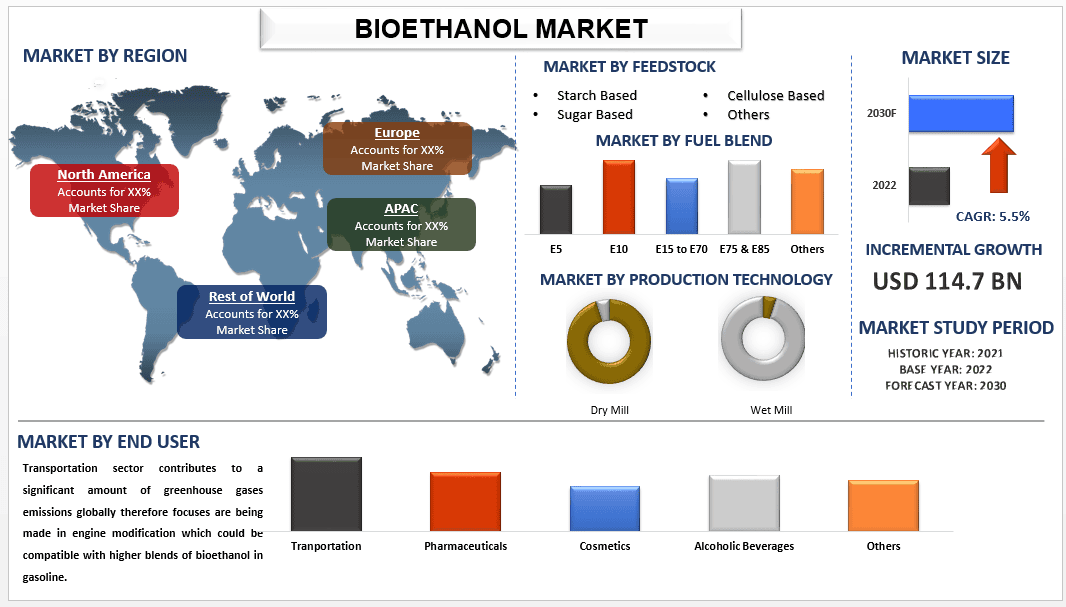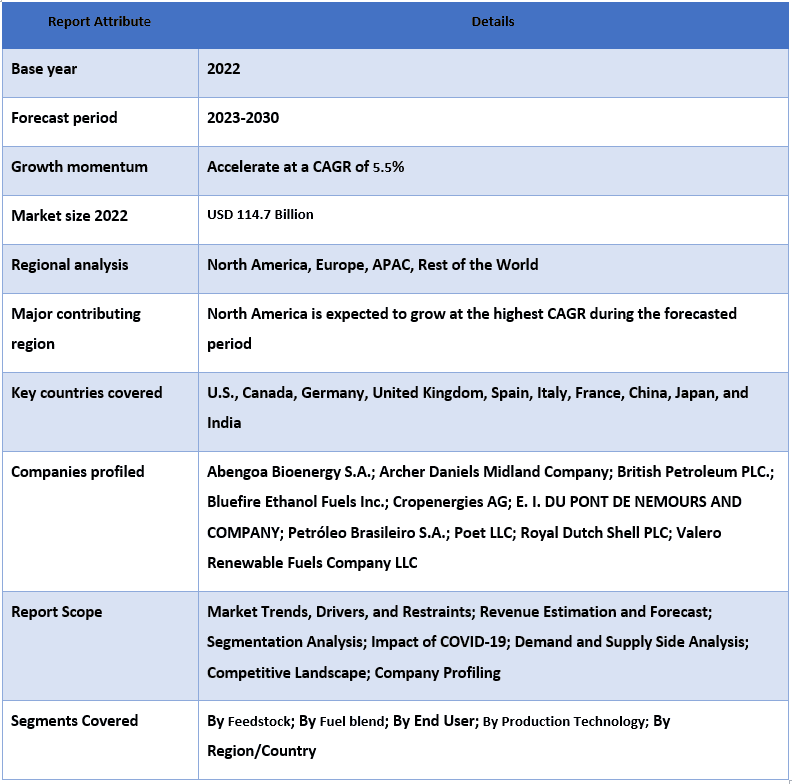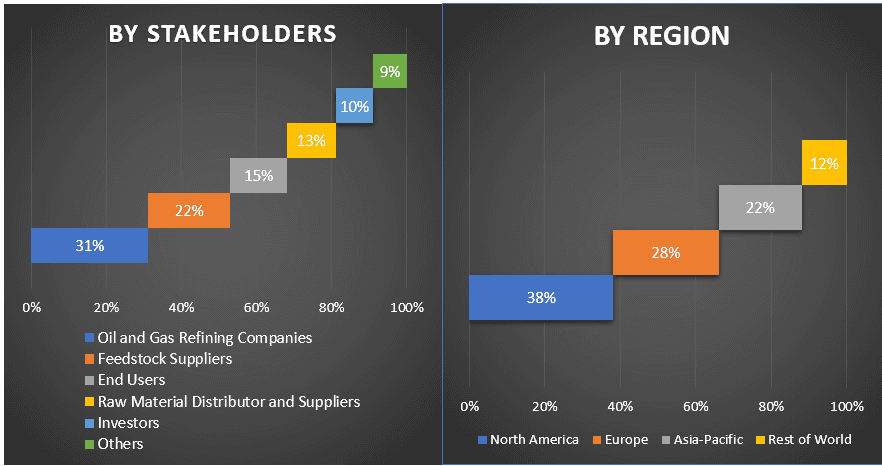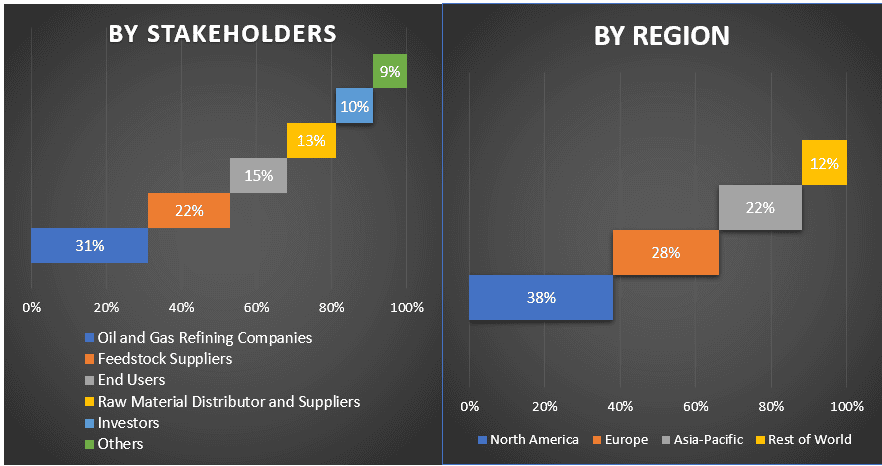Emphasis on Feedstock (Starch Based, Sugar Based, Cellulose Based, Others); Fuel Blend (E5, E10, E15 to E70, E75 & E85, Others); End User (Transportation, Pharmaceutical, Cosmetics, Alcoholic Beverages, Others), Production Technology (Dry Mill, Wet Mill, Others); and Region/Country

The global bioethanol market was stood around $114.7 billion in 2022 and is expected to showcase double digit growth during the forecast period (2023-2030). Global warming is a major concern in present scenario. In May 2022, Blue Biofuels Inc. revealed that the fifth generation of their Cellulose-to-Sugar (“CTS”) machine is on track, and that testing and further engineering toward bigger volumes has begun. Blue Biofuels has also worked out a plan and hired K.R. Komarek Inc. to manufacture the successors to the fifth-generation CTS machine through commercialization.. Thus, with replacing fossil fuel with bioethanol could help in decarbonize the environment. Moreover, high octane number of bioethanol makes it an attractive and one of most suitable alternatives to conventional fuel. High blend of bioethanol in gasoline lessens the knocking effect in the engine thereby increasing the efficiency of the vehicle. This makes bioethanol a clean fuel owing to low emission of carbon monoxide to the environment. These factors coupled with stringent government policies would increase the demand of bioethanol market exponentially during the forecast period.
Insights Presented in the Report
“Amongst Feedstock, starch and sugar-based category significant market share.”
Based on feedstock, bioethanol market is categorized as starch base, sugar base, cellulose base, and others. In 2022, starch and sugar-based category held the significant market. This is mainly owing to government focuses on increasing crop cultivation which are extensively used in bioethanol production. Further, cellulosic feedstocks are fuel based and include crop residues, wood residues, dedicated energy crops, and industrial and other wastes. Cellulosic feedstocks offer several advantages over starch and sugar-based feedstocks.
“Amongst End User, transportation sector held considerable market share.”
Based on end user, the market is categorized into transportation, pharmaceuticals, cosmetics, and alcoholic beverages. Transportation sector contributes to a significant amount of greenhouse gases emissions globally therefore focuses are being made in engine modification which could be compatible with higher blends of bioethanol in gasoline. in 2022, owing to the increased usage of bioethanol as a transportation fuel and mixing regulations imposed by numerous regulatory bodies, such the Renewable Fuel Standard (EPA RFS) and the Renewable Energy Directive (EU RED).
Bioethanol Market Report Coverage

“North America represents significant market share in Global Bioethanol Market.”
For a better understanding of the market adoption, report provide detailed analysis for major region and countries including North America (US, Canada, Rest of North America), Europe (Germany, UK, France, Spain, Rest of Europe), Asia-Pacific (China, Japan, India, Australia, Rest of APAC), and Rest of World. North America accounted for the significant market share in 2022 and is expected showcase considerable growth during the forecast period. Government regulations regarding use of ethanol blend would also propel the market size of bioethanol. In addition to this, availability of surplus raw material for producing bioethanol is also driving the market in the region. North America is one of the largest consumers of vehicle fuel in the world and uses different ethanol fuel blends. Countries including the US and Canada, and Mexico have mandated the use of higher ethanol blends in vehicles which would increase the demand for bioethanol as it uses agricultural waste and by- products.
Reasons to buy this report:
Customization Options:
The global bioethanol market can further be customized as per the requirement or any other market segment. Besides this, UMI understands that you may have your own business needs, hence feel free to connect with us to get a report that completely suits your requirements.
1. Market Introduction
2. Research Methodology Or Assumption
3. Market Synopsis
4. Executive Summary
5. Global Bioethanol Market Amid Covid-19
6. Global Bioethanol Market Revenue (usd Bn), 2020-2030f
7. Market Insights By Feedstock
8. Market Insights By Fuel Blend
9. Market Insights By End User
10. Market Insights By Production Technology
11. Market Insights By Region
12. Bioethanol Market Dynamics
13. Bioethanol Market Opportunities
14. Bioethanol Market Trends
15. Demand And Supply Side Analysis
16. Value Chain Analysis
17. Price Analysis
18. Competitive Scenario
19. Company Profiled
20. Disclaimer
Research Methodology for Global Bioethanol Market Analysis (2023-2030)
Analyzing the historical market, estimation of the current market, and forecasting the future market of the bioethanol were the three major steps undertaken to create and analyze its adoption across the globe. Exhaustive secondary research was conducted to collect the historical market numbers and estimate the current market size. Secondly, to validate these insights, numerous findings and assumptions were taken into consideration. Moreover, exhaustive primary interviews were also conducted, with industry experts across the value chain of the bioethanol industry. Post assumption and validation of market numbers through primary interviews, we employed a bottom-up approach to forecast the complete market size. Thereafter, market breakdown and data triangulation methods were adopted to estimate and analyze the market size of segments and sub-segments the industry pertains to. Detailed methodology is explained below:
Analysis of Historical Market Size
Step 1: In-Depth Study of Secondary Sources:
Detail secondary study was conducted to obtain the historical market size of the bioethanol market through company internal sources such as annual report & financial statements, performance presentations, press releases, etc., and external sources including journals, news & articles, government publications, competitor publications, sector reports, third-party database, and other credible publications.
Step 2: Market Segmentation:
After obtaining the historical market size of the bioethanol market, we conducted a detailed secondary analysis to gather current market insights and share for different segments & sub-segments for major regions. Major segments included in the report are by feedstock, fuel blend, end user, production technology, and region/country. Further regional and country-level analyses were conducted to evaluate the overall adoption of the bioethanol globally.
Step 3: Factor Analysis:
After acquiring the historical market size of different segments and sub-segments, we conducted a detailed factor analysis to estimate the current market size of bioethanol. Further, we conducted factor analysis using dependent and independent variables such as growing demand for clean energy due to rising environmental concerns among population etc. A thorough analysis was conducted for demand and supply-side scenario considering top partnerships, merger and acquisition, business expansion, and product launches in the bioethanol industry.
Current Market Size Estimate & Forecast
Current Market Sizing: Based on actionable insights from the above 3 steps, we arrived at the current market size, key players in the global bioethanol market, and market shares of each segment. All the required percentage shares split, and market breakdowns were determined using the above-mentioned secondary approach and were verified through primary interviews.
Estimation & Forecasting: For market estimation and forecast, weights were assigned to different factors including drivers & trends, restraints, and opportunities available for the stakeholders. After analyzing these factors, relevant forecasting techniques i.e., bottom-up approach was applied to arrive at the market forecast to 2027 for different segments and sub-segments across the major regions globally. The research methodology adopted to estimate the market size encompasses:
Market Size and Share Validation
Primary Research: In-depth interviews were conducted with the Key Opinion Leaders (KOLs) including Top Level Executives (CXO/VPs, Sales Head, Marketing Head, Operational Head, and Regional Head, Country Head, etc.) across major regions. Primary research findings were then summarized, and statistical analysis was performed to prove the stated hypothesis. Inputs from primary research were consolidated with secondary findings, hence turning information into actionable insights.
Split of Primary Participants in Different Regions

Market Engineering
Data triangulation technique was employed to complete the overall market estimation and to arrive at precise statistical numbers of each segment and sub-segment of the global bioethanol market. Data was split into several segments & sub-segments post studying various parameters and trends in the areas of feedstock, fuel blend, end user, production technology, and region.
The main objective of the Bioethanol Market Study
The current & future market trends of global bioethanol were pinpointed in the study. Investors can gain strategic insights to base their discretion for investments from the qualitative and quantitative analysis performed in the study. Current and future market trends would determine the overall attractiveness of the market at a country level, providing a platform for the industrial participant to exploit the untapped market to benefit as a first-mover advantage. Other quantitative goals of the studies include:
Deep dive country level analysis of the industry

Customers who bought this item also bought